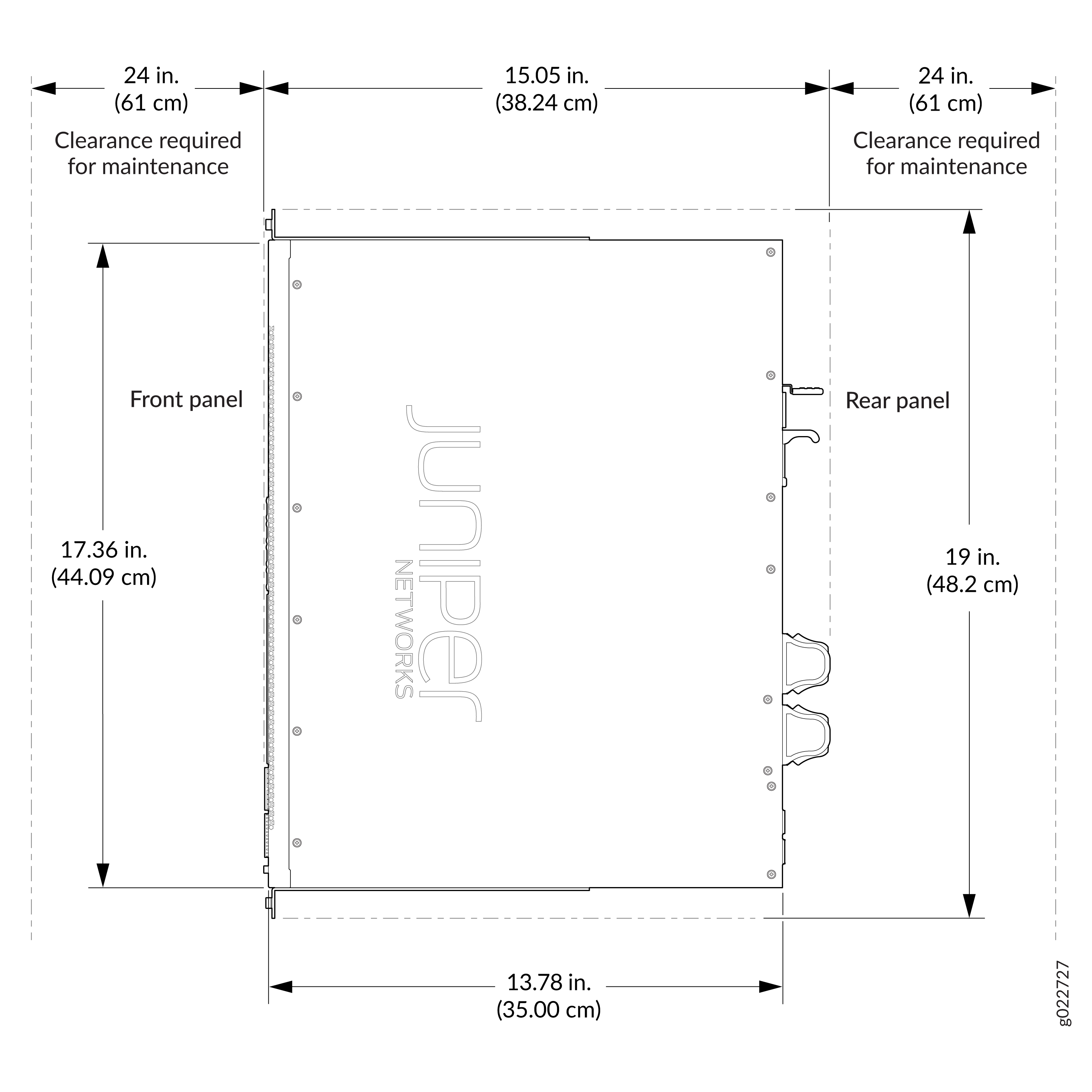EX4100 Site Guidelines and Requirements
Environmental Requirements and Specifications for EX4100 Switches
You must install the switch in a rack or cabinet. You must house it in a dry, clean, well-ventilated, and temperature-controlled environment.
Follow these environmental guidelines:
-
Ensure that the site is as dust-free as possible. Dust can clog air intake vents and filters, reducing the efficiency of the switch cooling system.
-
Maintain ambient airflow for normal switch operation. If the airflow is blocked or restricted, or if the intake air is too warm, the switch might overheat. If the switch overheats, the switch temperature monitor may shut down the device to protect the hardware components.
The following are the required environmental conditions for normal switch operation of EX4100 switches.
-
Switch: All EX4100 switch models
-
Altitude: No performance degradation up to 5,000 feet (1, 524 meters)
-
Relative humidity: Normal operation ensured in relative humidity range of 10% through 85%, noncondensing
-
Temperature:
-
Normal operation ensured in temperature range of 32 °F through 113 °F (0 °C through 45 °C)
-
Nonoperating storage temperature in shipping container: –40 °F through 158 °F (–40 °C through 70 °C)
-
-
Seismic tolerance: Tested for Zone 4 earthquake safety.
With 10G-Base-T pluggable, max temperature is reduced to 40C up to 5,000ft elevation.
Install the EX4100 switch only in restricted areas, such as dedicated equipment rooms and equipment closets. Install the switch in accordance with Articles of the National Electrical Code, ANSI/NFPA 70.
General Site Guidelines
Efficient device operation requires proper site planning. For the device to operate properly, you must ensure maintenance and proper layout of the equipment, rack or cabinet, and wiring closet.
To plan and create an acceptable operating environment for your device and prevent environmentally caused equipment failures:
Keep the area around the chassis free from dust and conductive material, such as metal flakes.
Follow the prescribed airflow guidelines to ensure that the cooling system functions properly. Ensure that the exhaust from other equipment does not blow into the intake vents of the device.
Follow the prescribed electrostatic discharge (ESD) prevention procedures to prevent damaging the equipment. Static discharge can cause components to fail completely or intermittently over time.
Install the device in a secure area, so that only authorized personnel can access the device.
Site Electrical Wiring Guidelines
Table 1 describes the factors you must consider while planning the electrical wiring at your site.
You must provide a properly grounded and shielded environment and use electrical surge-suppression devices.
Avertissement Vous devez établir un environnement protégé et convenablement mis à la terre et utiliser des dispositifs de parasurtension.
|
Site Wiring Factor |
Guidelines |
|---|---|
|
Signaling limitations |
If your site experiences any of the following problems, consult experts in electrical surge suppression and shielding:
|
|
Radio frequency interference |
To reduce or eliminate RFI from your site wiring, do the following:
|
|
Electromagnetic compatibility |
If your site is susceptible to problems with electromagnetic compatibility (EMC), particularly from lightning or radio transmitters, seek expert advice. Strong sources of electromagnetic interference (EMI) can cause:
|
Rack Requirements
You can mount the device on two-post racks or four-post racks.
|
Rack Requirement |
Guidelines |
|---|---|
|
Rack type |
A U is the standard rack unit defined by the Electronic Components Industry Association (ECIA) (http://www.ecianow.org). You can mount the device on a rack that provides bracket holes or hole patterns spaced at 1U (1.75 in. or 4.45 cm) increments and meets the size and strength requirements to support the weight. |
|
Mounting bracket hole spacing |
The holes in the mounting brackets are spaced at 1U (1.75 in. or 4.45 cm) so that the device can be mounted in any rack that provides holes spaced at that distance. |
|
Rack size and strength |
Ensure that the:
|
|
Rack connection to building structure |
|
Cabinet Requirements for EX4100 Switches
You can mount the device in a cabinet that contains a 19-in. rack.
Cabinet requirements consist of:
-
Cabinet size.
-
Clearance requirements.
-
Cabinet airflow requirements.
|
Cabinet Requirement |
Guidelines |
|---|---|
|
Cabinet size |
|
|
Cabinet clearance |
|
|
Cabinet airflow requirements |
When you mount the device in a cabinet, ensure that ventilation through the cabinet is sufficient to prevent overheating, as follows:
|
Clearance Requirements for Airflow and Hardware Maintenance for EX4100 Switches
When planning the site for installing an EX4100 switch, you must allow sufficient clearance around the installed switch.
See:
-
Figure 1 for clearance requirements for airflow and hardware maintenance for EX4100-24T, EX4100-24P, EX4100-48T, and EX4100-48P switches.

-
For the cooling system to function properly, the airflow around the chassis must be unrestricted.
-
If you are mounting the switch in a rack or cabinet with other equipment, or if you are placing it on the desktop or floor near other equipment, ensure that the exhaust from other equipment does not blow into the intake vents of the chassis.
-
Leave at least 24 in. (61 cm) in front of the switch and behind the switch for service personnel to remove and install hardware components,. It is recommended that you allow at least 30 in. (76.2 cm) in front of the rack or cabinet and 24 in. (61 cm) behind the rack or cabinet.
